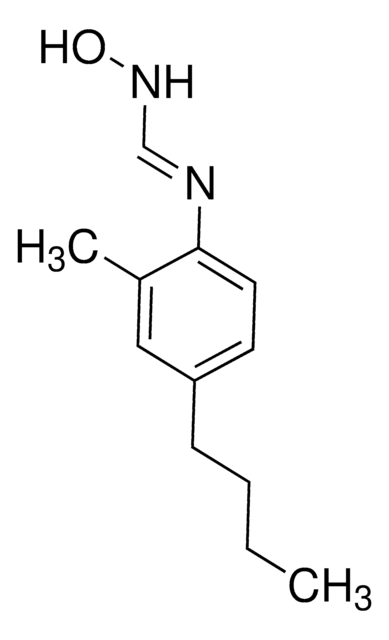H127
p-Fluorohexahydro-sila-difenidol hydrochloride
powder, ≥98% (HPLC)
Sinónimos:
Cyclohexyl-(4-fluorophenyl)-(3-N-piperidinopropyl)silanol hydrochloride, P-F-HHSiD hydrochloride
About This Item
Productos recomendados
Nivel de calidad
Análisis
≥98% (HPLC)
formulario
powder
color
white to beige
solubilidad
H2O: slightly soluble 1.5 mg/mL
45% (w/v) aq 2-hydroxypropyl-β-cyclodextrin: >14 mg/mL
ethanol: soluble
cadena SMILES
Cl[H].O[Si](CCCN1CCCCC1)(C2CCCCC2)c3ccc(F)cc3
InChI
1S/C20H32FNOSi.ClH/c21-18-10-12-20(13-11-18)24(23,19-8-3-1-4-9-19)17-7-16-22-14-5-2-6-15-22;/h10-13,19,23H,1-9,14-17H2;1H
Clave InChI
JMTYYLMGSBSPPK-UHFFFAOYSA-N
Información sobre el gen
human ... CHRM3(1131)
Aplicación
- as the M3/muscarinic acetylcholine receptor antagonist to study its involvement in carbachol induced Egr-1 biosynthesis using human neuroblastoma cells
- as M3 receptor antagonist to test its involvement on N,N-diethyl-m-toluamide (DEET)-induced angiogenesis in human umbilical venous endothelial cells (HUVEC)
- in a study to examine the role of aclidinium on human fibroblast to myofibroblast
Acciones bioquímicas o fisiológicas
Características y beneficios
Código de clase de almacenamiento
11 - Combustible Solids
Clase de riesgo para el agua (WGK)
WGK 3
Punto de inflamabilidad (°F)
Not applicable
Punto de inflamabilidad (°C)
Not applicable
Equipo de protección personal
Eyeshields, Gloves, type N95 (US)
Certificados de análisis (COA)
Busque Certificados de análisis (COA) introduciendo el número de lote del producto. Los números de lote se encuentran en la etiqueta del producto después de las palabras «Lot» o «Batch»
¿Ya tiene este producto?
Encuentre la documentación para los productos que ha comprado recientemente en la Biblioteca de documentos.
Nuestro equipo de científicos tiene experiencia en todas las áreas de investigación: Ciencias de la vida, Ciencia de los materiales, Síntesis química, Cromatografía, Analítica y muchas otras.
Póngase en contacto con el Servicio técnico